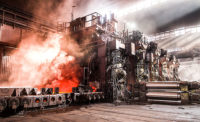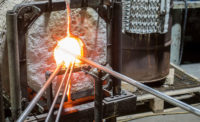Boilers, dryers, process ovens, thermal oxidizers or other fuel-fired industrial equipment are essential to manufacturing productivity. Regulating the flow and pressure of fuel delivery to this equipment requires a multi-component, highly-engineered device called a “valve safety train” that also helps to keep fuel out of the combustion chamber when equipment is cycled or shut off, and ensures emergency shutdowns take place if a problem occurs.
Owing to the presence of hazardous vapors and gases, a valve safety train that is not regularly inspected or maintained is a proverbial “ticking time bomb” on a factory floor. Over the past decade, valve train explosions have killed or severely injured dozens of people who happen to be in the wrong place at the wrong time. Unfortunately, it is only after a tragic event that organizations realize how potentially dangerous fuel delivery systems can be.
Valve safety train systems typically handle natural gas, but can also transport propane, landfill, methane, sewer gas, oil, air, nitrogen, or other types of bio-gas products. Regardless of the type of fuel handled, the maintenance, cleaning and repair of valve safety trains is mission critical to employee safety, equipment longevity, fuel efficiency, and process control.
Valve safety train engineering
To better appreciate what a valve safety train is – and isn’t – a brief overview of their engineering is in order.
Valve safety trains are a coordinated group of mechanical and electrical devices to manage and monitor fuel. At the heart of every valve safety train is a safety shut off valve (SSOV). The SSOV is the key safety component that ensures full flow isolation. Larger trains require dual-safety shutoff valves in series. Preceding the SSOV are various fuel-conditioning devices to clean the fuel and manage the pressure. After the SSOV, flow-control valves and other devices oftentimes support the fuel-delivery process. Augmenting these devices are various manual shut-off valves (MSOV) that are used to isolate the process for maintenance purposes. Gas pressure switches are incorporated at key locations to monitor fuel pressures and check against abnormal conditions. Additional ancillary devices such as pilot lines, vents, proving systems, instrumentation, or flow meters may be incorporated to provide specific process control needs.
Aside from the valve safety train, a burner management system (BMS) safety controller supervises and sequences light-offs and monitors safety. The BMS will direct fuel valves to close if a problem occurs. The safety premise of a BMS is to assume an unsafe condition exists unless each individual interlock has been proven and maintained in a safe condition. Only then will the BMS permit the combustion system to operate.
Components must be listed or approved for their intended service by a nationally recognized testing agency such as Underwriters Laboratories (UL), Factory Mutual (FM) or the American Gas Association (AGA). On some applications an expert from the underwriting authority or local government will need to inspect the valve safety train before it is put into service.
Operational dangers
Valve safety trains, like all industrial equipment, wear with use. For instance:
- Fuel flowing to a system can convey condensate, piping scale or other foreign materials that will either damage or block a safety valve from fully closing.
- Diaphragm devices are vulnerable to embrittlement, aging, and rupture.
- Outdoor trains ensure seasonal extremes, adverse weather and UV exposure.
- Control valves and linkages may loosen with cycling.
- Debris accumulates in fans, burners and air piping, altering air-to-fuel ratios, and reducing energy efficiency.
- Incorrectly vented valves, relief devices, regulators and pressure switches can fail to properly respond upon use, or not react at all.
- Gas pressure switches should be wired with a means that will prevent fuel from a failed switch flowing through a conduit or wiring to an electrical enclosure. Such a failure could cause an explosion if the fuel were to reach an arcing contact inside the electrical system.
- If plug valves are installed, they must be properly serviced with the correct sealant. Plug valves that are low on sealant may leak externally, or permit fuel to bypass a closed valve. Excessive use of sealant can build up in the piping, which may subsequently flow into other components.
- Employees may defeat, bypass or jumper-out safety controls, creating unknown hazards.
Add up these dangers and the need for valve safety train inspection and maintenance by trained technicians becomes readily apparent.
The entire combustion safety system should be inspected at least annually, both internally and externally while out of service, to assure compliance. Consult with NFPA 86 (Ovens and Furnaces) as a starting point. However, because NFPA 86 is only a minimum standard, the Authority Having Jurisdiction (AHJ) has the final say.
Annual testing and preventive maintenance are also typical requirements of insurance agencies, but other codes (sometimes overlapping) and standards may need to be adhered to besides NFPA. These may include ANSI, ASME, NEC, and the EPA. Oil-fired burners must comply with UL-296 Standard for Oil Burners, UL-726 Standard for Oil-Fired Boiler Assemblies, or UL-2096 Standard for Commercial/Industrial Gas and/or Oil-Burning Assemblies with Emission Reduction Equipment. If inspections are not completed within the allotted time or if they are ignored, the plant owner may lose insurance coverage.
Only highly-trained, experienced flame control technicians should perform valve safety train inspections. During the inspection, analysis of code compliance or deficiencies will be conducted, as will a review of maintenance practices regarding fuel delivery. Upon conclusion of the inspection, a written report with data and photographic documentation will be presented to the plant manager. When done regularly, this written report allows the manager to compare and contrast the valve safety train’s condition with that of previous inspections.
It is always best practice to hire skilled contractors for inspections and major maintenance. However, if your organization is planning to do its own basic preventive maintenance, begin by reviewing NFPA 54: The National Fuel Gas Code, which details safe gas-piping repair practices. Like NFPA 86, it is required reading. Basic maintenance and housekeeping procedures that an in-house staff can perform include:
Safety shutoff valve leak testing
If a gas train has a double safety shutoff valve and vent line, you will need to perform a monthly test on each valve to ensure gas is not leaking into the combustion chamber or up the vent. At the very least, a leak will cost money in lost fuel, and reduce efficiency of the burner.
Flame color and shape
You can learn a lot from a burner flame. Check it daily. If it has been over a year since the last air-to-fuel ratio tuning, hire a technician to adjust it. Your flame should produce a clean burn with no soot or smoke, and exhibit a uniform flame envelop. Natural gas flames that are blue or violet mean you have a lean fire with excessive amounts of air. Unchecked, an excessively lean fire will create high levels of CO and white smoke. If your flame burns yellow, however, you have a fuel rich fire. An orange flame or one that produces dark smoke is dangerous — shut off the fuel immediately.
Vent line inspection
Many vent lines are old and not maintained. When a venting device fails, it stays partially open and flows fuel to the vent line. Some failed devices will result in a loss of control, but not always. Regardless of the cause, raw gas pours out the vent whenever equipment is pressurized. Failure is often uncovered only when someone reports the smell of gas. NFPA does state that all safety devices shall be tested on a regular basis. Some manufacturers offer “ventless” solutions as an option. This reduces the labor and material cost for installing proper venting.
Don’t adjust the burner purge cycle
One of the best maintenance steps you can take is to not take it at all: do not adjust the burner purge cycle. This feature prevents explosions caused by a buildup of unburned fuel in the chamber. Ensure the timers work, are properly set and maintained. Certainly, it is frustrating when a boiler fails to ignite, which requires one to wait for another complete purge cycle. But don’t use that frustration to justify doing something rash like shortening or bypassing the purge cycle. Doing so greatly increases the chances of a serious explosion.
Failure to inspect and keep valve safety trains in proper working order will certainly result in higher fuel costs, reduced heat transfer, equipment deterioration and, worst of all, increased potential for a catastrophic explosion. Do not let your organization be fooled by what is hidden in plain sight.






